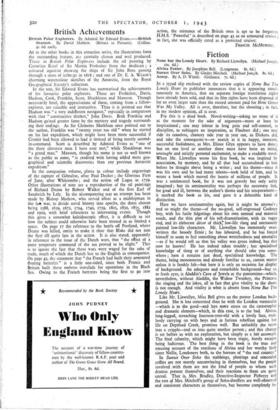British Achievements
British Polar Explorers. By Admiral Sir Edward Evans.—British Seamen. By David Mathew. (Britain in Pictures). (Collins. 45. 6d. each).
As in the other books in this attractive series, the illustrations form the outstanding feature, arc carefully chosen and weil produced. Those in Brinsh Polar Explorers include the oil painting by Cornelius Ketel of Sir Martin Frobisher from the Bodleian ; a coloured aquatint showing the ships of Sir John Ross passing .through a mass of icebe:gs in 1818; and one of Dr. E. A. Wilson's charming watercolour sketches of the Antarctic, from the Royal Geupaphical Society's collection. In the text, Sir Edward Evans has summarised the achievements of his favourite polar explorers. These are Frobisher, Davis, Hudson, Cook, Franklin, Scott, Shaddeton and Mawson. Though necessarily brief, the appreciations of these, coming from a fellow- explorer, are valuable and instructive. Thus it is pointed out that Hudson was "a very indifferent navigator," especially in comparison with that "constructive thinker," John Davis. Both Franklin and Hudson gained greater fame by the mystery and tragedy surround- ing their endings. As Sir Clements Markham once pointed out to the author, Franklin was "twenty years too old" when he started on his last expedition, which might have been more successful if Crozier had been allowed to lead it instead of being merely second- in-command. Scott is described by Admiral Evans as "one of the three cleverest men I have ever met," while Shackleton was "a grand man." Mawson, though his name is not so well known to the public as some, "is credited with having added more geo- graphical and scientific discoveries than any previous Antarctic expedition."
In the companion volume, plates in colour include engravings of the capture of Gibraltar, after Paul Decker ; the Glorious First of June, after Whitcombe ; and the action off Lagos in 1759. Other illustrations of note are a reproduction of the oil paintings of Richard Deane by Robert Walker and of the first Earl of Sandwich by Lely. In the accompanying text an attempt has been made by Bishop Mathew, who served afloat as a midshipman in the last war, to divide naval history into epochs, the dates chosen being 1588, 1639, 1672, 1704, 1740, 1759, 1805, 1830, 1855, 1882 and 1910, with brief references to intervening events. Though this gives a somewhat kaleidoscopic effect, it is difficult to see how the subject could otherwise hate been treated in so limited a space. On page 17 the reference to the battle off Portland, where Deane was killed, omits to make it clear that Blake did not join the fleet till quite late in the action. It is also stated, apparently in reference to the issue of the Dutch wars, that "the effect of a mere temporary command of the sea proved to be slight" This is to ignore the fact that these wars were waged for the sake. of trade, much of which the Dutch lost to the English in consequence. On page 42, the statement that "the French had built their armoured floating batteries" is a little one-sided, since both France and Britain built these embryo iroriclads for operations in the Black Sea. Owing to the French batteries being the first to go into
action, the existence of the British ones is apt to be forgotten. H.M.S. ' Powerful ' is described on page 45 as an armoured cruiser ; in fact, she was officially .rated as a protected cruiser.
FRANCIS MCMURTRIE.


























 Previous page
Previous page